© 2021 All rights reserved
Datavagyanik- Your Research Partner
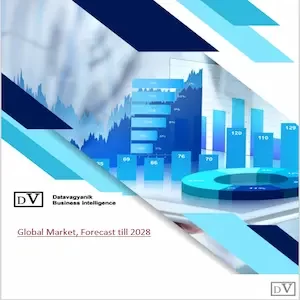
The Food Antioxidants industry stood at $1,346 million in 2020 and the demand is expected to grow at a CAGR of around 5.2% during the forecast period (Till 2030). In terms of source, the food antioxidants market has been split into segments: synthetic sources, fruits & vegetables, oils, spices & herbs and others. Synthetic antioxidants segment is a relatively larger contributor to the overall market. In 2020, the synthetic antioxidants segment generated a revenue of $772.3 million. The segment would attain a size of $1,079.8 million by 2027, growing at a CAGR of 4.7%.
The fruits & vegetables segment held a market share of 23.1% with a revenue of $311.2 million in 2020. Demand for natural antioxidants is rising at a faster pace with increasing health concerns. Carotenoids, Tocopherols, Botanical Extracts, vitamin C and Vitamin E are the majorly used.
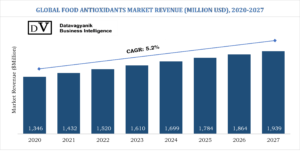
There are several types of synthetic as well as natural antioxidants that are most common in the food industry. BHA and BHT are two most common food additives used presently. Synthetic antioxidants hold around 57% of the market share in the food antioxidants market.
Natural antioxidants are also very popular owing to their health benefits. In fact, in the past, some of the reputed food and snack brands announced that they are going to minimize the use of synthetic antioxidants in their products. For example, earlier, General Mills announced that it is removing the antioxidant butylated hydroxytoluene (BHT) from its cereals. By the year 2027, the global market share of synthetic food antioxidants will decline slightly from 57.4% in 2020 to 55.7%. However, they will continue to hold a dominant market share.

Some of the sources of natural antioxidants used in the food industry are:
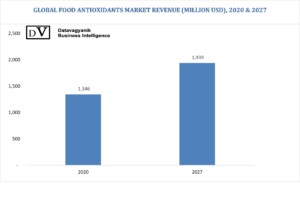
The food antioxidants market has been split into segments namely meat & poultry, fats & oils, bakery & confectionery, snacks & dairy, beverages and others. Out of these customer segments, meat & poultry products and fats & oils generate the highest demand for food antioxidants.
In 2020, the meat & poultry segment accounted for 32.8% of the revenue share and a revenue of $441.3 million. The second largest segment was fats & oils with a share of 24.4% and a revenue of $328.7 million.

In terms of growth, the beverage segment is the fastest growing. The segment held a market share of 6.2% in 2020 and generated a revenue of $83.8 million. The segment is expected to grow at around 8.1% every year during the period (2021 – 2027). World consumption of non-alcoholic beverages has significantly increased over the last decade, and data projections indicate that this increase will be even greater, due to factors such as population growth and demand for diversification of products. The demand for functional drinks, sports beverages and other health & fitness drinks is on the rise.
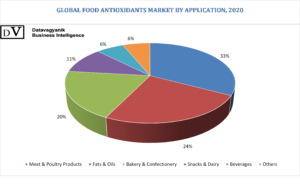
One of the main classes of additives used in beverages with nutritional value are antioxidants, such as hydroxyanisole (BHA), butylated hydroxytoluene (BHT), tertbutylhydroxyquinone (TBHQ), and propyl gallate (PG) that have been used in antioxidative food systems. Tocopherols and ascorbic acid or their derivatives are being used as alternatives to BHA, BHT, TBHQ and PG as antioxidants considered natural.
North America region comprises of the U.S., Canada and Mexico. In the present scenario, the North America region is the second largest market for food antioxidants, after the APAC region. The economy of the United States is highly developed and is world’s largest economy by nominal GDP and net wealth. It also has the world’s eighth-highest per capita GDP (nominal) and the tenth-highest per capita GDP (PPP) in 2020. The United States exhibits the highest demand for premium quality food and beverage products. In 2020, the United States food antioxidants market size was $325.1 million and is expected to attain a size of $423.4 million by 2027.
Canada held a market share of 9.6% in the North America food antioxidants market with a market size of $37.3 million in 2020. The country is expected to reach $50.2 million by 2027, growing at around 4.1%. Mexico generated a revenue of $28.2 million with a market share of 7.2% in the North American region.
Asia Pacific region accounts for 37% of the total food antioxidants market. The region generated a revenue $498.8 million in 2020. In the Asia Pacific region, China is the largest market with a market share of 40.8% and revenue of over $200 million. Growing at a CAGR of around 6.7%, the country is expected to attain a size of over $325.4 million by 2027.
Japan, is the second largest market for food antioxidants in the Asia Pacific region. The country stood at $64.9 million in terms of revenue with a regional market share of 13%. It is expected to reach $92.8 million by 2027, growing at around 5.1%.
Thailand is one of the fastest growing market in the APAC region. The country stood at $39.8 million in terms of food antioxidants market size with a regional market share of 8%.
The Asia-Pacific region offers lucrative growth opportunities for market players. Increasing adoption of western lifestyle and rising disposable income of consumers are the major factors that would drive the market. This region offers potential opportunities to market players for supplying high quality antioxidants. Therefore, manufacturers are focusing on expand their business in this region to increase their customer base and improve their geographical outreach. Moreover, the countries in Latin America, such as Brazil, would unfold attractive opportunities in during the forecast period due to rising demand for bakery and snack products.
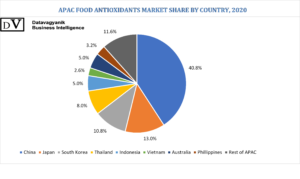
Better-for-you food & beverages comprise of premium quality food & beverages, with reduced fats, sodium and sugar content. There is a huge demand of such products in North America and Europe and the trend is picking up fast in other parts of the world. Moreover, developing economies have witnessed a rapid growth in demand of healthy food & beverages, including snacks, desserts and soft drinks in the recent years. Breakfast cereals, whole wheat pasta, spreads, cookies and desserts are few of the examples where antioxidants are being used. Demand for natural antioxidants is rising at a faster rate as compared to their synthetic counterparts as these are relatively healthier and safer.
Some of the important players operating in the Food Antioxidants market are – BASF SE, ARCHER-DANIELS-MIDLAND COMPANY, DU PONT, BARENTZ, KEMIN INDUSTRIES, EASTMAN CHEMICAL COMPANY, CAMLIN FINE SCIENCES LTD, CARGILL, KONINKLIJKE DSM N.V.
The report analyzes Food Antioxidants market from demand as well as supply side. In supply side analysis, we reach out to the Food Antioxidants market players to collect information on their portfolio, revenue, target customers and other insights. During this process, paid interviews and surveys are conducted for obtaining and validating the data pointers. We also deep dive into the available paid industry databases, research studies, white papers and annual reports.
As a part of our demand side analysis, we reach out to the end users of Food Antioxidants, to gauge the application areas, demand trends and similar insights.
This business analysis report on the Food Antioxidants market presents a regional as well as country level analysis. The regions covered in the report are – North America, Europe, Asia Pacific and Rest of the World. In these four regions, all the countries have been covered in detail with information on Food Antioxidants market size, trends and forecast.
The report covers Food Antioxidants market revenue and forecast for the period (till 2030), by regions, (further split into countries):
FOOD ANTIOXIDANTS MARKET REVENUE ($MILLION), AND FORECAST, till 2030
| Year | 2023 | 2025 | 2027 | 2029 | CAGR (till 2030) |
| Food Antioxidants Market Revenue ($Million) | XX | XX | XX | XX | XX |
| Total | XX | XX | XX | XX | XX |
*Note – Country-level break-down has been covered in the report
Food Antioxidants Market Player Analysis:
Food Antioxidants Market Research Methodology:
There is an entire data collection and validation framework that Datavagyanik follows to provide you with authentic information. We connect to industry experts across various countries to understand market trends and demand pattern. The same is done through paid interviews and surveys.
Our internal team of analysts are experts in studying market pattern, mining data and extracting useful information from different paid as well as freely available sources. Datavagyanik has exhaustive internal data base with information on markets, market players and other macro and micro economic indicators that impact industries.
1. Executive Summary
1.1. Market Attractiveness Analysis
1.2. Global Food Antioxidants Market, By Application
1.3. Global Food Antioxidants Market, By Source
1.4. Global Food Antioxidants Market, By Type
1.5. Global Food Antioxidants Market, By Geography
2. Research Methodology
2.1. Research Process
2.2. Primary Research
2.3. Secondary Research
2.4. Market Size Estimation
2.5. Forecast Model
2.6. List of Assumptions
3. Market Dynamics
3.1. Introduction
3.2. Drivers
3.3. Restraints
3.4. Opportunities
3.5. Challenges
3.6. Covid 19 Impact Analysis
4. Global Food Antioxidants Market Analysis
4.1. Overview
4.2. Global Food Antioxidants Market size ($Million) and Forecasts (till 2030)
4.1. Global Food Antioxidants Market size ($Million) and Forecasts (till 2030), By Application
4.1.1. Fats and Oils
4.1.2. Snacks and Dairy
4.1.3. Meat products
4.1.4. Beverages
4.1.5. Bakery and Confectionery
4.1.6. Seafood
4.1.7. Others
4.2. Global Food Antioxidants Market size ($Million) and Forecasts (till 2030), By Source
4.2.1. Fruits and Vegetables
4.2.2. Oils
4.2.3. Nuts and Seeds
4.2.4. Spices and Herbs
4.2.5. Petroleum
4.2.6. Gallic Acid
4.3. Global Food Antioxidants Market size ($Million) and Forecasts (till 2030), By Type
4.3.1. Synthetic Food Antioxidants
4.3.2. Natural Food Antioxidants
4.4. Global Food Antioxidants Market size ($Million) and Forecasts (till 2030), By Geography
4.4.1. North America
4.4.2. Asia Pacific
4.4.3. Europe
4.4.4. Rest of the World
5. NORTH AMERICA Food Antioxidants Market analysis
5.1. Overview
5.2. North America Food Antioxidants Market size ($Million) and Forecasts (till 2030)
5.3. North America Food Antioxidants Market size ($Million) and Forecasts (till 2030), By Application
5.3.1. Fats and Oils
5.3.2. Snacks and Dairy
5.3.3. Meat products
5.3.4. Beverages
5.3.5. Bakery and Confectionery
5.3.6. Seafood
5.3.7. Others
5.4. North America Food Antioxidants Market size ($Million) and Forecasts (till 2030), By Source
5.4.1. Fruits and Vegetables
5.4.2. Oils
5.4.3. Nuts and Seeds
5.4.4. Spices and Herbs
5.4.5. Petroleum
5.4.6. Gallic Acid
5.5. North America Food Antioxidants Market size ($Million) and Forecasts (till 2030), By Type
5.5.1. Synthetic Food Antioxidants
5.5.2. Natural Food Antioxidants
5.6. North America Food Antioxidants Market size ($Million) and Forecasts (till 2030), By Country
5.6.1. United States
5.6.2. Canada
5.6.3. Mexico
6. EUROPE Food Antioxidants Market analysis
6.1. Overview
6.2. Europe Food Antioxidants Market size ($Million) and Forecasts (till 2030)
6.3. Europe Food Antioxidants Market size ($Million) and Forecasts (till 2030), By Application
6.3.1. Fats and Oils
6.3.2. Snacks and Dairy
6.3.3. Meat products
6.3.4. Beverages
6.3.5. Bakery and Confectionery
6.3.6. Seafood
6.3.7. Others
6.4. Europe Food Antioxidants Market size ($Million) and Forecasts (till 2030), By Source
6.4.1. Fruits and Vegetables
6.4.2. Oils
6.4.3. Nuts and Seeds
6.4.4. Spices and Herbs
6.4.5. Petroleum
6.4.6. Gallic Acid
6.5. Europe Food Antioxidants Market size ($Million) and Forecasts (till 2030), By Type
6.5.1. Synthetic Food Antioxidants
6.5.2. Natural Food Antioxidants
6.6. Europe Food Antioxidants Market size ($Million) and Forecasts (till 2030), By Country
6.6.1. Germany
6.6.2. France
6.6.3. Italy
6.6.4. Spain
6.6.5. U.K.
6.6.6. Rest of Europe
7. Asia Pacific Food Antioxidants Market analysis
7.1. Overview
7.2. Asia Pacific Food Antioxidants Market size ($Million) and Forecasts (till 2030)
7.3. Asia Pacific Food Antioxidants Market size ($Million) and Forecasts (till 2030), By Application
7.3.1. Fats and Oils
7.3.2. Snacks and Dairy
7.3.3. Meat products
7.3.4. Beverages
7.3.5. Bakery and Confectionery
7.3.6. Seafood
7.3.7. Others
7.4. Asia Pacific Food Antioxidants Market size ($Million) and Forecasts (till 2030), By Source
7.4.1. Fruits and Vegetables
7.4.2. Oils
7.4.3. Nuts and Seeds
7.4.4. Spices and Herbs
7.4.5. Petroleum
7.4.6. Gallic Acid
7.5. Asia Pacific Food Antioxidants Market size ($Million) and Forecasts (till 2030), By Type
7.5.1. Synthetic Food Antioxidants
7.5.2. Natural Food Antioxidants
7.6. Asia Pacific Food Antioxidants Market size ($Million) and Forecasts (till 2030), By Country
7.6.1. China
7.6.2. Japan
7.6.3. South Korea
7.6.4. India
7.6.5. Australia
7.6.6. Malaysia
7.6.7. Vietnam
7.6.8. Rest of APAC
8. Rest of the World Food Antioxidants Market analysis
8.1. Overview
8.2. Rest of the World Food Antioxidants Market size ($Million) and Forecasts (till 2030)
8.3. Rest of the World Food Antioxidants Market size ($Million) and Forecasts (till 2030), By Application
8.3.1. Fats and Oils
8.3.2. Snacks and Dairy
8.3.3. Meat products
8.3.4. Beverages
8.3.5. Bakery and Confectionery
8.3.6. Seafood
8.3.7. Others
8.4. Rest of the World Food Antioxidants Market size ($Million) and Forecasts (till 2030), By Source
8.4.1. Fruits and Vegetables
8.4.2. Oils
8.4.3. Nuts and Seeds
8.4.4. Spices and Herbs
8.4.5. Petroleum
8.4.6. Gallic Acid
8.5. Rest of the World Food Antioxidants Market size ($Million) and Forecasts (till 2030), By Type
8.5.1. Synthetic Food Antioxidants
8.5.2. Natural Food Antioxidants
9. Company Profiles
9.1. BASF
9.1.1. Company Overview
9.1.2. Products Offered
9.1.3. Key Developments
9.1.4. Revenue from Food Antioxidants Business Segment, 2020 & 2021
9.2. Du Pont
9.2.1. Company Overview
9.2.2. Products Offered
9.2.3. Key Developments
9.2.4. Revenue from Food Antioxidants Business Segment, 2020 & 2021
9.3. Archer-Daniels-Midland Company
9.3.1. Company Overview
9.3.2. Products Offered
9.3.3. Key Developments
9.3.4. Revenue from Food Antioxidants Business Segment, 2020 & 2021
9.4. Kemin Industries, Inc.
9.4.1. Company Overview
9.4.2. Products Offered
9.4.3. Key Developments
9.4.4. Revenue from Food Antioxidants Business Segment, 2020 & 2021
9.5. Eastman Chemical Company
9.5.1. Company Overview
9.5.2. Products Offered
9.5.3. Key Developments
9.5.4. Revenue from Food Antioxidants Business Segment, 2020 & 2021
9.6. Barentz
9.6.1. Company Overview
9.6.2. Products Offered
9.6.3. Key Developments
9.6.4. Revenue from Food Antioxidants Business Segment, 2020 & 2021
9.7. Camlin Fine Sciences Ltd
9.7.1. Company Overview
9.7.2. Products Offered
9.7.3. Key Developments
9.7.4. Revenue from Food Antioxidants Business Segment, 2020 & 2021
9.8. Eastman Chemical Company
9.8.1. Company Overview
9.8.2. Products Offered
9.8.3. Key Developments
9.8.4. Revenue from Food Antioxidants Business Segment, 2020 & 2021
9.9. Other Market Players
“Every Organization is different and so are their requirements”- Datavagyanik




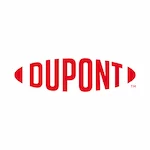


© 2021 All rights reserved
Datavagyanik- Your Research Partner
Add the power of Impeccable research, become a DV client